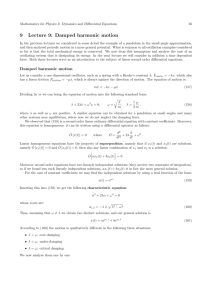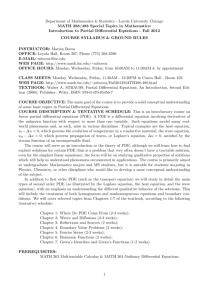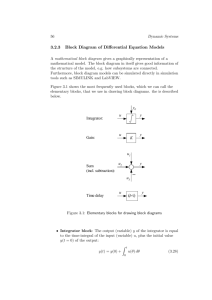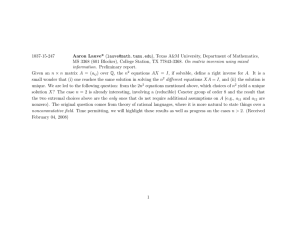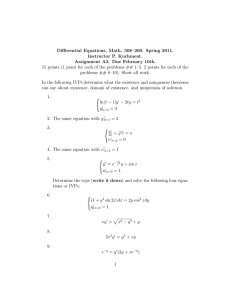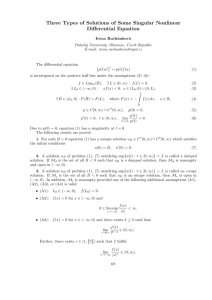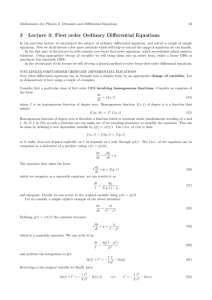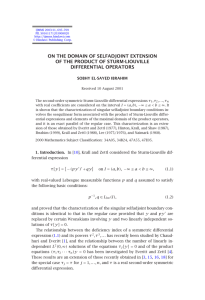AVERAGING OF MULTIVALUED DIFFERENTIAL EQUATIONS G. GRAMMEL
advertisement
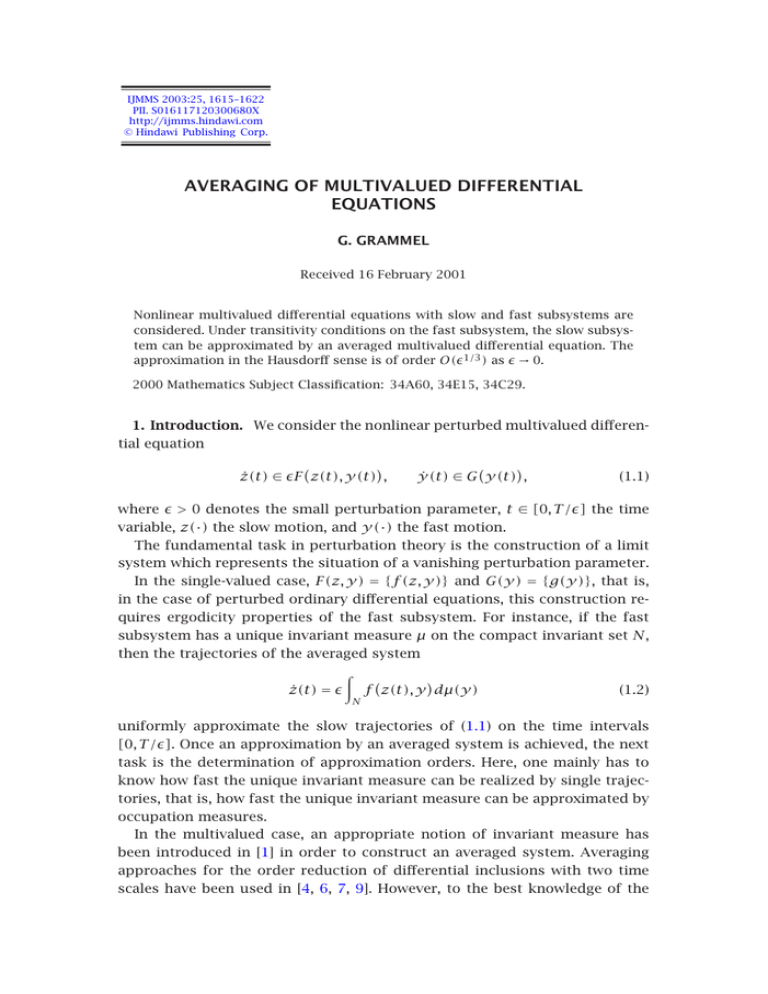
IJMMS 2003:25, 1615–1622
PII. S016117120300680X
http://ijmms.hindawi.com
© Hindawi Publishing Corp.
AVERAGING OF MULTIVALUED DIFFERENTIAL
EQUATIONS
G. GRAMMEL
Received 16 February 2001
Nonlinear multivalued differential equations with slow and fast subsystems are
considered. Under transitivity conditions on the fast subsystem, the slow subsystem can be approximated by an averaged multivalued differential equation. The
approximation in the Hausdorff sense is of order O(1/3 ) as → 0.
2000 Mathematics Subject Classification: 34A60, 34E15, 34C29.
1. Introduction. We consider the nonlinear perturbed multivalued differential equation
ż(t) ∈ F z(t), y(t) ,
ẏ(t) ∈ G y(t) ,
(1.1)
where > 0 denotes the small perturbation parameter, t ∈ [0, T /] the time
variable, z(·) the slow motion, and y(·) the fast motion.
The fundamental task in perturbation theory is the construction of a limit
system which represents the situation of a vanishing perturbation parameter.
In the single-valued case, F (z, y) = {f (z, y)} and G(y) = {g(y)}, that is,
in the case of perturbed ordinary differential equations, this construction requires ergodicity properties of the fast subsystem. For instance, if the fast
subsystem has a unique invariant measure µ on the compact invariant set N,
then the trajectories of the averaged system
(1.2)
ż(t) = f z(t), y dµ(y)
N
uniformly approximate the slow trajectories of (1.1) on the time intervals
[0, T /]. Once an approximation by an averaged system is achieved, the next
task is the determination of approximation orders. Here, one mainly has to
know how fast the unique invariant measure can be realized by single trajectories, that is, how fast the unique invariant measure can be approximated by
occupation measures.
In the multivalued case, an appropriate notion of invariant measure has
been introduced in [1] in order to construct an averaged system. Averaging
approaches for the order reduction of differential inclusions with two time
scales have been used in [4, 6, 7, 9]. However, to the best knowledge of the
1616
G. GRAMMEL
author, aside from the periodic case (see [8]), the problem of determining approximation orders for perturbed multivalued differential equations has not
been discussed yet.
The main purpose of the present paper is to show that, under transitivity
conditions on the fast motion, approximation orders O(1/3 ), as → 0, can be
achieved. This result complements an analogous result on singularly perturbed
differential equations in [5], where the same approximation order is deduced
from certain mixing properties of the fast flow.
2. Preliminaries and main result. The setting is as follows.
Assumption 2.1. The state space of (1.1) is Rm × Rn . There is a compact
subset N ⊂ Rn such that Rm ×N is invariant with respect to (1.1). The set field
(F , G) is Lipschitz continuous in the Hausdorff sense on Rm ×Rn with Lipschitz
constant L ≥ 0, and has compact, convex, and nonvoid images. The function F
is bounded on Rm ×N; there is a constant P ≥ 0 such that F (z, y) ⊂ BP (0) ⊂ Rm
for all (z, y) ∈ Rm × N.
The initial conditions are
z(0) = z0 ∈ Rm ,
y(0) = y 0 ∈ N.
(2.1)
In the sequel, we focus on the fast subsystem
ẏ(t) ∈ G y(t) ,
y(0) = y 0 ∈ N.
(2.2)
We introduce the solution map
SG : N → ᏼ C [0, ∞); N
(2.3)
which maps every y 0 ∈ N to the set of solutions of the fast subsystem. Here, a
solution is a Lipschitz continuous curve t y(t) with y(0) = y 0 , which fulfils
the inclusion of (2.2) for almost all t ≥ 0.
Then the averaged inclusion is constructed in the following way. First, we
define for all (z, y 0 ) ∈ Rm × N and S > 0 the finite time average:
0
FS z, y := cl
y(·)∈SG (y 0 )
1
S
S
F z, y(t) dt ,
(2.4)
0
where the integral is understood in the usual sense as the union of the integrals of all measurable selections v(·) ∈ F (z, y(·)). The following transitivity
assumption is crucial.
AVERAGING OF MULTIVALUED DIFFERENTIAL EQUATIONS
1617
Assumption 2.2. For any y, y 0 ∈ N, there is a time t ≥ 0 and a solution
y(·) ∈ SG (y 0 ) of the fast subsystem with y = y(t).
Lemma 2.3. Suppose that Assumptions 2.1 and 2.2 are fulfilled. There is a
limit set field F0 on Rm with closed, uniformly bounded, convex, and nonvoid
images such that uniformly in z ∈ Rm and y 0 ∈ N, the finite time averages
satisfy the estimate
dH FS z, y 0 , F0 (z) = O S −1/2 ,
as S → ∞.
(2.5)
This limit set field F0 on Rm defines the averaged differential inclusion
ż(t) ∈ F0 z(t) ,
z(0) = z0 .
(2.6)
In order to formulate the approximation theorem in a concise way, we define
the solution maps for the original and the averaged system. Here, ᏼ(X) denotes
the power set of a set X. The function
S(F ,G) : Rm × N → ᏼ C [0, T /]; Rm × N
(2.7)
maps every (z0 , y 0 ) ∈ Rm × N to the set of solutions of (1.1) and (2.1), and
SF0 : Rm → ᏼ C [0, T /]; Rm
(2.8)
maps every z0 ∈ Rm to the set of solutions of (2.6). We remark that the setvalued maps S(F ,G) , SG , and SF0 have compact images; compare, for example,
[2, Theorem 3.5.2]. Therefore, we can use the Hausdorff metric, which we denote by dH (·, ·), for the images of the solution map.
Theorem 2.4. Suppose that Assumptions 2.1 and 2.2 are fulfilled. Then the
following estimate is valid:
dH ΠS(F ,G) z0 , y 0 , SF0 z0 = O 1/3 ,
as → 0,
(2.9)
uniformly in (z0 , y 0 ) ∈ Rm ×N, where Π : C([0, T /], Rm ×N) → C([0, T /], Rm )
is the projection.
What follows is a short discussion on the assumptions.
Assumption 2.1 is standard. First, we mention that the system (1.1) has a
particular structure since the fast flow is decoupled. Without this structure, it
may happen that the averaged system is not Lipschitz anymore, and no approximation orders can be expected. Concerning the fast flow, Lipschitz continuity
is not really needed and could be replaced by upper semicontinuity. In this
case, we would need to introduce a uniform bound on t ≥ 0 in Assumption 2.2.
1618
G. GRAMMEL
We have already mentioned that Theorem 2.4 complements a result in [5],
where the same approximation order is achieved for ordinary differential equations with decoupled mixing fast flows. But Theorem 2.4 is by no means a multivalued generalization. This is due to the fact that the transitivity condition,
formulated in Assumption 2.2, is a typical multivalued feature and reduces to
a periodicity condition in the single-valued case. However, the regularity conditions used in the present paper are weaker than in [5], where the vector fields
are of class C 1 .
3. Proofs
Proof of Lemma 2.3. First, we show that the time t ≥ 0, which is needed
for the transition from one point y 0 ∈ N to another point y ∈ N (see
Assumption 2.2), is uniformly bounded. For t ≥ 0 and y 0 ∈ N, we set
A t, y 0 :=
y(t)
(3.1)
y(·)∈SG (y 0 )
and note that A(t, y 0 ) ⊂ N is compact in N according to Assumption 2.1. By
Baire’s theorem, there is an n ∈ N such that A(n, y 0 ) has interior points in N.
Then the claim follows by standard compactness arguments.
As a consequence, we obtain the estimate
dH FS z, y10 , FS z, y20 = O S −1 ,
as S → ∞,
(3.2)
uniformly in z ∈ Rm and y10 , y20 ∈ N. We conclude that
dH
k
1 0
0
FS z, y , FkS z, y
= O S −1 ,
k i=1
as S → ∞,
(3.3)
uniformly in k ∈ N, holds. Moreover, it follows by a well-known fact from
convex analysis that the estimate
dH
k
1 0
0
FS z, y , conv FS z, y
= O k−1 ,
k i=1
as k → ∞,
(3.4)
uniformly in S > 0, is true. Combining the last two estimates, we obtain
dH FS 2 z, y 0 , conv FS z, y 0 = O S −1 ,
as S → ∞.
(3.5)
From this we conclude that FS (z, y 0 ) is a Cauchy sequence, as S → ∞, and the
lemma’s statement follows.
AVERAGING OF MULTIVALUED DIFFERENTIAL EQUATIONS
1619
Proof of Theorem 2.4. (I) Let (T , ) ∈ R+ × R+ . We divide the time interval in subintervals of the form [tl , tl+1 ] which all have the same length S > 0,
except for the last one which may be smaller. Accordingly, the index l is an
element of the index set I := {0, . . . , [T /(S )]}. Later, we will define a map
S .
(II) We take some initial values (z0 , y 0 ) ∈ Rm ×N and a solution (z (·), y (·))
∈ S(F ,G) (z0 , y 0 ). We have
z tl+1 = z tl +
tl+1
tl
ż (t)dt,
(3.6)
where ż (·) ∈ F (z (·), y (·)) is a measurable selection. For l ∈ I , we set ξ0 :=
z0 and
ξl+1 := ξl +
tl+1
tl
wl (t)dt,
(3.7)
where wl (·) ∈ F (ξl , y (·)) is a particular measurable selection to be specified
later.
We define for all l ∈ I ,
∆l := ξl − z tl ,
dl := max z (t) − ξl .
(3.8)
tl ≤t≤tl+1
We observe that
dl ≤ ∆l + S P .
(3.9)
According to the Filippov lemma (cf., e.g., [3, Proposition 3.4(b)]), there is a
measurable selection wl (·) ∈ F (ξl , y (·)) with
ż (t) − wl (t) ≤ Ldl
(3.10)
for almost all t ∈ [tl , tl+1 ]. We conclude that
∆l+1 ≤ ∆l +
tl+1
tl
ż (t) − wl (t)ds
≤ ∆l + S Ldl
≤ ∆l 1 + S L + 2 S2 P .
(3.11)
Considering that ∆0 = 0 and l ≤ T /S , we obtain
∆l ≤ 2 S2 P
l−1
i=0
i
1 + S L ≤ S P T eT L .
(3.12)
1620
G. GRAMMEL
According to Lemma 2.3, we can choose a vl ∈ F0 (ξl ) such that
1 tl+1
vl −
wl (s)ds ≤ O S−1/2 .
S tl
(3.13)
For all l ∈ I , we define η0 := z0 and
ηl+1 := ηl + S vl .
(3.14)
We interpolate piecewise linearly and set, for t ∈ [tl , tl+1 ],
ηl (t) := ηl + t − tl vl .
(3.15)
Obviously, we have for all l ∈ I ,
ηl − ξl ≤ T O S −1/2 .
(3.16)
For t ∈ [tl , tl+1 ], we have
dist η̇l (t), F0 ηl (t) ≤ dH F0 ξl , F0 ηl + dH F0 ηl , F0 ηl (t)
≤ LT O S−1/2 + 2 LS P .
(3.17)
According to the Filippov theorem, there is a solution z0 (·) ∈ SF0 (z0 ) of the
averaged system (2.6) with
z0 tl − ηl ≤ LT 2 O S −1/2 + T LS P eLT .
(3.18)
By (3.12), (3.16), and (3.18), we can estimate
z tl − z0 tl ≤ S P T eT L + T O S −1/2
+ LT 2 O S−1/2 + T LS P eLT .
(3.19)
(III) We take an initial value z0 ∈ Rm and a solution z0 (·) ∈ SF0 (z0 ) of the
averaged differential inclusion (2.6). We furthermore choose an arbitrary initial
value y 0 ∈ N. Then we have for all l ∈ I and almost all t ∈ [tl , tl+1 ],
≤ 2 LS P .
dist ż0 (t), F0 z0 tl
(3.20)
AVERAGING OF MULTIVALUED DIFFERENTIAL EQUATIONS
1621
By the convexity of F0 (z0 (tl )) we even have for all l ∈ I ,
1
dist
S
tl+1
tl
≤ 2 LS P .
ż0 (t)dt, F0 z0 tl
(3.21)
For all l ∈ I , we choose vl ∈ F0 (z0 (tl )) in a way that
1 tl+1
ż0 (t)dt − vl ≤ 2 LS P
S tl
(3.22)
and define δ0 := z0 and
δl+1 := δl + S vl .
(3.23)
Then we can estimate for all l ∈ I ,
z0 tl − δl ≤ T LS P .
(3.24)
For l ∈ I , we define successively ξ0 := z0 and
ξl+1 := ξl + S wl ,
(3.25)
where wl ∈ FS (ξl , y(tl )) is chosen such that
vl − wl ≤ dist vl , F0 δl + dH F0 δl , F0 ξl
+ dH F0 ξl , FS ξl , y tl
≤ 2 L2 T S P + Lδl − ξl + O S−1/2 .
(3.26)
Notice that, by the choice of the wl ∈ FS (ξl , y(tl )), we obtain successively a
trajectory y (·) of the fast subsystem of (1.1). Then we have for all l ∈ I ,
δl+1 − ξl+1 ≤ δl − ξl + S vl − wl ≤ δl − ξl 1 + S L + 2 S2 L2 T P + S O S−1/2 .
(3.27)
Since l ≤ T /(S ) for all l ∈ I and δ0 − ξ0 = 0, we conclude that
i
l−1
δl − ξl ≤ 2 S 2 L2 T P + S O S −1/2
1 + S L
≤ L2 T S P + O S−1/2 eLT .
i=0
(3.28)
1622
G. GRAMMEL
Similarly, as in part (II) of this proof, we can estimate for all l ∈ I ,
ξl − z tl ≤ S P T eLT
(3.29)
for a solution z (·) of the slow subsystem of (1.1). By (3.24), (3.28), and (3.29),
we can estimate
z0 tl − z tl ≤ S T LP + S L2 T P + O S −1/2 eT L + S P T eLT .
(3.30)
(IV) Considering that, for t ∈ [tl , tl+1 ], we have
z0 (t) − z0 tl ≤ S P ,
z (t) − z tl ≤ S P ,
(3.31)
the claim follows by (3.19) and (3.30), setting
S := −2/3 .
(3.32)
References
[1]
[2]
[3]
[4]
[5]
[6]
[7]
[8]
[9]
Z. Artstein, Invariant measures of differential inclusions applied to singular perturbations, J. Differential Equations 152 (1999), no. 2, 289–307.
J.-P. Aubin, Viability Theory, Systems & Control: Foundations & Applications,
Birkhäuser Boston, Massachusetts, 1991.
K. Deimling, Multivalued Differential Equations, de Gruyter Series in Nonlinear
Analysis and Applications, vol. 1, Walter de Gruyter, Berlin, 1992.
T. Donchev and I. Slavov, Averaging method for one-sided Lipschitz differential
inclusions with generalized solutions, SIAM J. Control Optim. 37 (1999), no. 5,
1600–1613.
H. S. Dumas and F. Golse, The averaging method for perturbations of mixing flows,
Ergodic Theory Dynam. Systems 17 (1997), no. 6, 1339–1358.
O. P. Filatov and M. M. Khapaev, Averaging of differential inclusions with “fast”
and “slow” variables, Mat. Zametki 47 (1990), no. 6, 102–109 (Russian).
G. Grammel, Singularly perturbed differential inclusions: an averaging approach,
Set-Valued Anal. 4 (1996), no. 4, 361–374.
V. A. Plotnikov, Averaging of differential inclusions, Ukrain. Mat. Zh. 31 (1979),
no. 5, 573–576 (Russian).
, Averaging method for differential inclusions and its application to optimal
control problems, Differential Equations 15 (1980), 1013–1018.
G. Grammel: Center for Mathematics M6, Technical University Münich, Arcisstr. 21,
80290 Münich, Germany
E-mail address: grammel@appl-math.tu-muenchen.de
